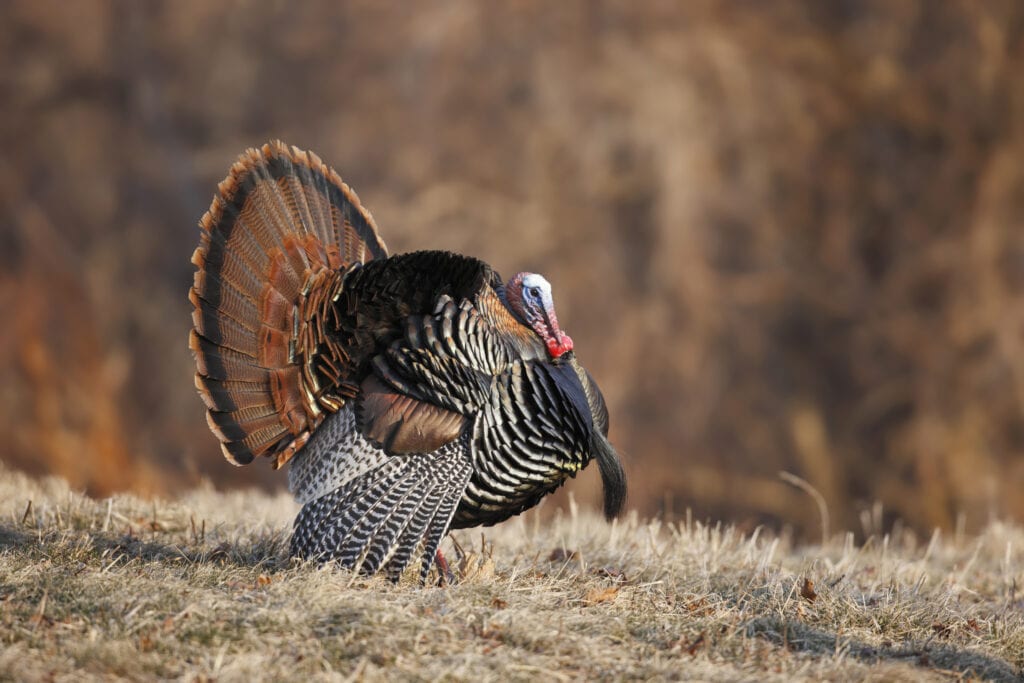
CASPER, Wyo — Each year, hunters put over 1,000 Wyoming turkeys on tables, and wild turkey numbers are up this fall, according to the Wyoming Game and Fish Department (WGFD).
“After two years of good hatches and survival, Wyoming’s wild turkey numbers have improved in many areas, especially in northeast Wyoming,” said Joe Sandrini, a Newcastle area wildlife biologist and wild turkey researcher, in a WGFD release Monday celebrating the upcoming Thanksgiving holiday.
But it wasn’t until 1955 that hunters were first able to harvest the historic wild turkey in Wyoming, the WGFD said.
“It all started in 1935 when the Wyoming Game and Fish Department swapped sage grouse with New Mexico for 15 Merriam’s turkeys – nine hens and six toms,” Game and Fish said.
After the Merriams were released on the George Waln Ranch on Cottonwood Creek in Platte County, they reportedly lured some of the ranch’s domestic turkeys with them into the Laramie Mountains.
“The turkeys thrived in these hills west of Wheatland under the auspices of ranchers and the Game and Fish and were estimated to number over 1,000 by 1947,” the release said.
Those Laramie Peak birds served as seed stock for several futile reintroduction attempts across the state until birds were sowed into the fertile habitat of Redwater Creek in the northwest Black Hills between 1951 and 1952.
“They probably combined forces with some transplants that strayed over from South Dakota releases, and the introduction served as the foundation for Wyoming’s most recognized turkey hunt area,” Game and Fish said.
Hunting Tips:
“Fall turkey hunting is a different ballgame than the camouflaged calling of the spring,” Game and Fish said, adding that all turkey hunters should consider wearing orange or pink for safety as big game seasons are still underway, even though turkeys can spot the colors.
Sandrini suggests hunters work on a stealthy pursuit at middle to lower elevations as the season moves from fall to early winter. Wild turkeys tend to congregate closer to ranch and farm compounds.
“When flocks are startled and busted up, the birds can often be called back as they seek to reunite. Doing this from a concealed location is an effective fall hunting technique that is used in many parts of the country,” Sandrini said.
Cooking tips:
Compared to domestic turkeys, wild turkeys have less fat and consequently tend to be a little drier, Game and Fish advised.
A “cooking bag” can help the fowl retain its natural moisture. The breast can also be covered with bacon strips and baked in foil for all but the last few minutes before serving to brown the bird. Brining and smoking also help retain moisture and compliment the wild flavor.
Wild turkeys won’t stay on their backs while cooking like domestic birds and may need to be propped up, Game and Fish advised.
The wild specimen’s longer legs and smaller, fuller-flavor breast are much preferred to the commercial variety, Game and Fish said. The flavor is a result of the wild birds’ diet of hawthorne and scrub oak nuts, chokecherries, plums, currants and buffalo berries. Seasonally, the birds will also pluck tender grass shoots and buds.
Turkeys also eat grasshoppers when they are abundant, and juveniles eat them almost exclusively during their first summer, Game and Fish said. Ranchers often return the favor by letting the birds use their yards as winter refuge from deep snow.
“Strutting grounds” and other facts:
As spring approaches, the birds move up in elevation and flocks of gobblers or adult males start disbanding. In March, gobblers start establishing themselves in “strutting grounds” along the edge of creek bottoms or forests, the WGFD said.
“With loud gobbles and strutting postures, males amass a several-hen harem and drive smaller rivals off,” she wrote.
Hens nest in the strutting ground vicinity and close to reliable water. The females lay about two eggs every three days until a clutch of 10 to 13 is produced.
The chicks hatch after about 28 days of incubation “with no help from the gobblers,” Game and Fish said.
Within a week the chicks start flying and roost in trees thereafter. Hens and their brood, often joined by comparable broods, stay together until the next breeding season.
"fish" - Google News
November 23, 2021 at 03:20AM
https://ift.tt/3oPVqpA
Game and Fish celebrates the history of state’s wild turkeys, with hunting and cooking tips - Oil City News
"fish" - Google News
https://ift.tt/35JkYuc
https://ift.tt/3feFffJ
Bagikan Berita Ini















0 Response to "Game and Fish celebrates the history of state’s wild turkeys, with hunting and cooking tips - Oil City News"
Post a Comment